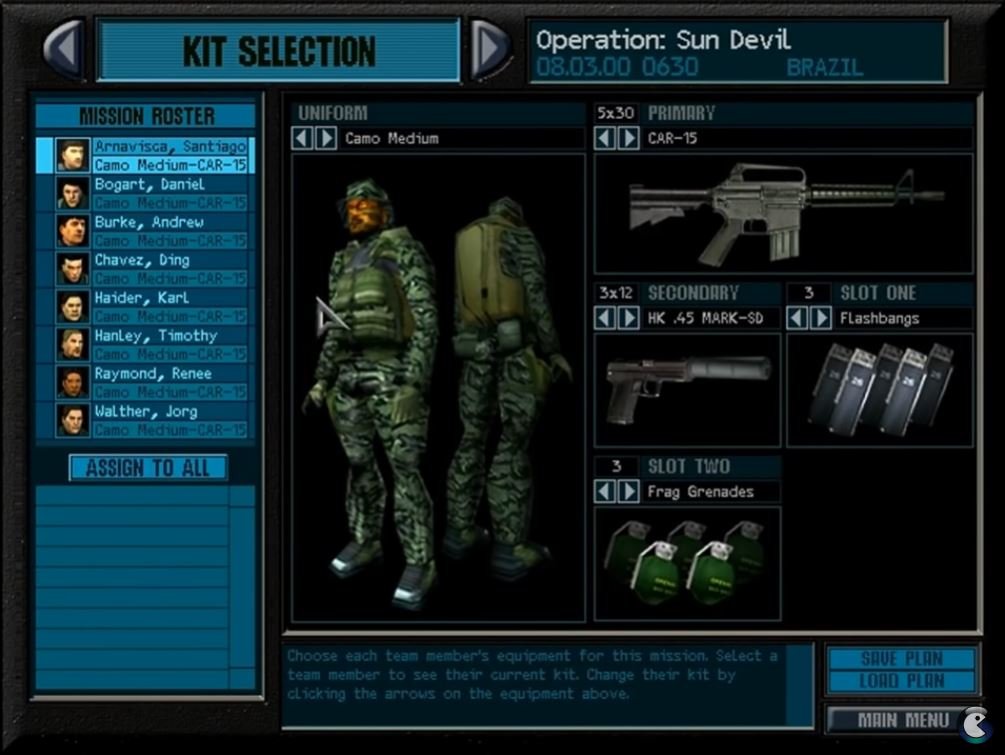Tom Clancy’s Rainbow Six
Release Date - August 21, 1998 (NA)
Developer - Red Storm Entertainment
Publisher - Red Storm Entertainment
Platform - PC
Tom Clancy is a novelist known for his grounded, detailed stories that cover espionage, tactical military manoeuvres and near-future technology. His published works include The Hunt for Red October (1984), The Sum of All Fears (1991) and Rainbow Six (1998).
The attention to detail and reality focused novels were perfectly captured in the video game adaption of Rainbow Six, the first video game to represent the ‘Tom Clancy’s’ brand; and the one that would establish the quality and tone that it would become known for in the future.
Fingers on triggers, but be careful; there are hostages to rescue as well.
(All images taken from https://youtu.be/A-Cldz20iGo)
Just looking at the cover of Rainbow Six and you immediately can tell this game is different to the usual fare. It’s just a man in tactical gear and a balaclava pointing a pistol, all in glorious night-vision green tint. It’s both understated and threatening. This game is going to be a raw, unfiltered experience.
The novel Rainbow Six covers an elite international counter-terrorist unit named ‘Rainbow’, and its leader John Clark, codename: Rainbow Six. In the game, you’ll be leading the Rainbow team, tackling a series of seemingly unconnected terrorist situations, slowly uncovering a larger conspiracy at play.
‘Understated’ is one way to put it. The game is eerily realistic with all the environments being mundane areas with authentic ambient noise. It’s surprisingly immersive.
This is one of the earliest major examples of the ‘tactical shooting’ genre. One bullet means death. Jump into the tutorial and you’ll immediately see just how much there is to this game, the training courses are strict and methodical, because the stakes are very high. Lose your focus for one moment and you might fail to see an enemy on the balcony above you, who’ll subsequently put two rounds in your back. Game over with no chance to react.
Preparation is the key to victory in Rainbow Six. Planning your mission is just as important, perhaps more important than playing out the mission itself! Before you even get to go into action, you’ll be met with a major aspect of Rainbow Six’s gameplay of pouring over building plans, equipment and available operators to bring in on the mission. You’ll of course be briefed on your targets, your objectives and any background information available. Based on this information it’s your job to decide on what equipment you must equip your teams with. Will you need heavy weapons for lots of resistance? You might need to also consider extra ammunition magazines in that case! Could you use that space to carry some electronics gear instead? Is it better to just use an explosive charge on any locked doors, because there’s no time to pick the locks?
Tweaking your team’s loadout is just as compelling as being on the mission itself. There’s a lot of options to allow you to experiment and cover for contingencies as best as possible.
Of course, you’ll also have to plan the route of each assault team. Open the blue-prints for the building and provide way-points for each of your teams, along with how they should approach each room. In early missions you can have the computer create some of these paths for you, but you’ll need to do it yourself as you progress deeper into the campaign.
‘No plan survives contact with the enemy’, so goes the old saying. This is the other major aspect of Rainbow Six, taking control of Rainbow’s leader and going into the mission proper. You’ll be in command of one team directly, while the others will proceed according to the plans you’ve laid out. This has the potential to be very frustrating for any gamer, but thankfully the AI of your other teams is pretty damn sharp, and you can rely on them to get the job done and follow your planning. You’ll even get regular updates via your radio from the other teams letting you know when they’re in position and waiting for your next ‘go’ order. Make sure you look after your team-mates well, because deaths in Rainbow Six are permanent! That’s right, there is a limited pool of operators to choose for each mission, and if one of them dies in action, they’re gone for good. There’s nothing worse than losing a top soldier to a careless mistake, and knowing they won’t be available again for the rest of the game!
Target down, he never stood a chance. Nice tracksuit though…
The action takes place in first-person or third person perspective which you can switch between at will. Although the first-person shooter view may seem familiar, the gameplay is a far cry from titles like Quake (1996) or Half-Life (1998). You’ll need to be on your guard constantly, as the enemy will react to your movements and your actions. They’ll send out patrols if they suspect you’re nearby, and they’ll even begin shooting hostages or setting off explosives if they feel cornered. Plan for things to go wrong, because they will. Scout every room, check every corner and be wary of every doorway and window before moving on because death comes quickly. You can freely switch between first and third person views during the mission as required. First person is great for fine aiming and close up inspection, while third person perspective helps a lot with awareness of your surroundings.
Seeing your team carry out their instructions in real time is pretty rewarding. Here you see two members are breaching the door while the rest make their way around to another entry.
The campaign will serve up varied missions from start to finish to keep things interesting (and challenging) the whole way through. Mission objectives and locations change up a lot, from hostage rescues to hunting for planted explosives, from British embassies to hydro-electric dams.
Even once you get through the single player campaign, there’s a multi-player mode included too. Big teams can face off against each-other in tactical combat with scenarios like assault, hostage capture and even good old-fashioned death matches. The addition of real humans to play with (or against) is a great addition to a game built around squad tactics. You can even set up games to have a team of human players co-operating against the AI. Even the humble death-match feels so unique in Rainbow Six with the lethality still being as high as in the single-player modes, and added threat of booby trap explosives and gadgets giving savvy players an edge.
Planning your route through the level with the aid of building blueprints is a major part of the game.
The game had fantastic attention to detail, only made more obvious by the real-world settings. While your team is almost always wearing a face-covering mask, you can still identify them by their eyes. They even have breathing animations while standing idle! Unsurprisingly for a game like this one, the sound design is excellent and lends so much to the atmosphere. Listening out carefully for enemies, and the sounds of suppressed gunfire and incoming radio messages make for an engrossing experience.
Rainbow Six was a game that took a chance on doing something different, and this risk paid off. The game was released to overwhelmingly critical response, especially because it was just so different to just about every other shooting game that was released in 1998. Over 200,000 copies were sold in the first year of release, becoming a massive hit for the developer/publisher Red Storm Entertainment. The ‘Gold’ edition released in 1999 would sell a further 300,000 units. It was ported to multiple different consoles, including the PlayStation, Nintendo 64 and Dreamcast. Rainbow Six was popular enough to even eclipse the original novel in fame, becoming a long-running franchise with multiple games and lasting over two decades with more in the pipeline. It’s worth going back and experiencing the original, just remember to stay frosty, check your corners and plan every step.
There aren’t many games that give you that ‘I could die any minute’ feeling as well as Rainbow Six.








